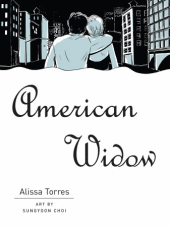 "My life is like a comic book!" I said. "I should write a comic book!" And that's what I did.
"My life is like a comic book!" I said. "I should write a comic book!" And that's what I did.It was the condolence letter and card from NASA that I received in June 2002, that got me to say these words and got me started writing my graphic novel memoir about my 9/11 widowhood. The letter explained in moving detail how NASA had sent out 6,000 small cloth American flags on a roundtrip space voyage for the 9/11 families. One of those flags was glued to the card I'd received, which also contained images of the International Space Station orbiting the Earth and another with the space shuttle Endeavor coming in for a landing.
The words made me cry, and the absurd gesture made me laugh. I imagined the time, effort, and resources it took to come up with this plan and to execute it. It reminded me of so many other efforts that had been made on my behalf over the year that had been well meaning but off-the-mark and funny. It made me realize how befuddled we are when it comes to expressing and dealing with grief.
Although this was how I began writing an "adult comic book," it wasn't what sustained this project as a graphic novel through the many long years it took to publish the book. It was the graphic nature of 9/11 that made me know that it was important to tell this story with images. For so long after 9/11, images of the burning towers were everywhere. And for me, as I spent so much time in my grief looking at my husband's pictures, I felt that this was a story most powerfully expressed with pictures of what once was but was now lost.
But by the summer of 2005, I regretted writing my memoir as a graphic novel. I couldn't find an artist. And I thought: "If I'd just stuck to prose, I could have already completed the book! And whether or not it got published, I would have had it as a finished piece." Instead my book, now a ready script, was still a shapeless endeavor. It needed an artist to bring it to life. I was devastated to think I'd never publish the book, especially since writing it had become such a therapeutic experience for me. I learned so much about myself in the process: about who I was, what I'd experienced, and who I'd become.
The following year, everything came together --- just like that. In the early fall of 2006, I met the artist, Sungyoon Choi. I loved her work for its quiet intelligence and sweetness. I asked her to create a few sample pages of the book to determine if we could work together. Just as she finished those pages, publishers were suddenly interested in the book. Then Villard/RandomHouse bought it.
As Choi spent the next year and a half drawing the book, I spent that time anxious. Now that its publication was going to be a reality, I dreaded what I thought was to come next with the book's sales and marketing efforts. I thought that all my therapeutic benefits from the book would get undone as the press poked at me with uncomfortable questions and people would say to me all kinds of embarrassing things.
Instead, when the book came out this fall, I was amazed by the magic it brought. I reconnected with old friends who came to hear me speak at some scheduled readings, and I made new friends wherever I went. The vulnerability of my book about love and loss, topics that are dear to us all, allowed others to be vulnerable too, and to share themselves with me and with others. This aspect was most apparent when I was a guest at my friend's book club on the night that the group talked about American Widow, its current book club selection. The women I met were excited about the book, and I loved listening to their thoughts and insights. I got to see the way my book created a strong intimacy for this group that had not been together long, giving them the running board from which to leap into conversation about things that are so hard yet so meaningful in our lives.
When I decided to write this book I never imagined the process and the result to be so rewarding. I cannot believe that what began as an impulsive statement became something that has become such a wonderful memorial to my husband and a gift to so many readers.
---Alissa Torres






